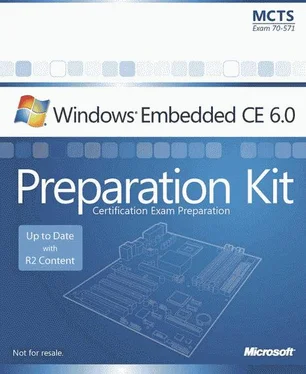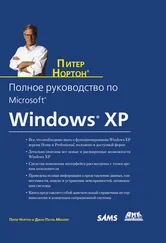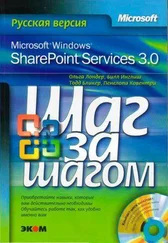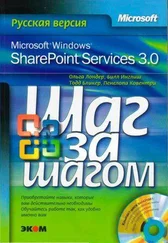Nicolas Besson - Microsoft Windows Embedded CE 6.0 Exam Preparation Kit
Здесь есть возможность читать онлайн «Nicolas Besson - Microsoft Windows Embedded CE 6.0 Exam Preparation Kit» весь текст электронной книги совершенно бесплатно (целиком полную версию без сокращений). В некоторых случаях можно слушать аудио, скачать через торрент в формате fb2 и присутствует краткое содержание. Город: Redmond, Год выпуска: 2008, Издательство: Microsoft, Жанр: Руководства, ОС и Сети, Программы, на английском языке. Описание произведения, (предисловие) а так же отзывы посетителей доступны на портале библиотеки ЛибКат.
- Название:Microsoft Windows Embedded CE 6.0 Exam Preparation Kit
- Автор:
- Издательство:Microsoft
- Жанр:
- Год:2008
- Город:Redmond
- ISBN:нет данных
- Рейтинг книги:5 / 5. Голосов: 1
-
Избранное:Добавить в избранное
- Отзывы:
-
Ваша оценка:
- 100
- 1
- 2
- 3
- 4
- 5
Microsoft Windows Embedded CE 6.0 Exam Preparation Kit: краткое содержание, описание и аннотация
Предлагаем к чтению аннотацию, описание, краткое содержание или предисловие (зависит от того, что написал сам автор книги «Microsoft Windows Embedded CE 6.0 Exam Preparation Kit»). Если вы не нашли необходимую информацию о книге — напишите в комментариях, мы постараемся отыскать её.
Microsoft Windows Embedded CE 6.0 Exam Preparation Kit — читать онлайн бесплатно полную книгу (весь текст) целиком
Ниже представлен текст книги, разбитый по страницам. Система сохранения места последней прочитанной страницы, позволяет с удобством читать онлайн бесплатно книгу «Microsoft Windows Embedded CE 6.0 Exam Preparation Kit», без необходимости каждый раз заново искать на чём Вы остановились. Поставьте закладку, и сможете в любой момент перейти на страницу, на которой закончили чтение.
Интервал:
Закладка:
Kernel Debugger<\/strong>The kernel debugger integrates functionality required to configure a connection to a target device and download a run-time image to the target device. It allows the debugging of the OS, abbreviate drivers, and applications.<\/p>
Kernel Independent Transport Layer (KITL)<\/strong>The KITL is designed to provide an easy way to support debugging services.<\/p>
Kernel-Mode Driver<\/strong>A driver that runs in the kernel's memory space.<\/p>
Kernel Tracker<\/strong>This tool provides a visual representation on a development workstation of OS and application events occurring on a Windows Embedded CE-based device.<\/p>
Layered Driver<\/strong>A driver that is separated into several layers to make it easier to maintain and reuse code at a later date.<\/p>
Model Device Driver (MDD)<\/strong>The MDD layer of a layered driver has a standardized interface to the OS and Platform Device Driver (PDD) layer and performs all hardware independent processing related to the driver.<\/p>
Monolithic Driver<\/strong>A driver that is not separated into different layers. It can also mean any driver that does not conform to the standard Model Device Driver (MDD)/Platform Device Driver (PDD) layer architecture of CE, even if the driver does have its own layering scheme.<\/p>
Mutex<\/strong>A mutex object is a synchronization object whose state is set to signaled when it is not owned by any thread and nonsignaled when it is owned. A mutex can only be owned by a single thread at a time. It is used to represent a resource that should only be accessed by one thread at any given time, such as a global variable or a hardware device.<\/p>
Native Driver<\/strong>Touchscreen, Keyboard and Display drivers are the only native drivers existing in Windows Embedded CE and are managed by GWES rather than Device Manager.<\/p>
OEM adaptation layer (OAL)<\/strong>An OAL is a layer of code that logically resides between the Windows Embedded CE kernel and the hardware of your target device. Physically, the OAL is linked with the kernel libraries to create the kernel executable file.<\/p>
Operating System Benchmark (OSBench)<\/strong>A tool that is used to measure the performance of the scheduler.<\/p>
OS Design<\/strong>A Platform Builder for Windows Embedded CE6 R2 project that generates a customized binary runtime image of the Windows Embedded CE6 R2 operating system<\/p>
Platform Dependent Driver (PDD)<\/strong>The PDD layer of a layered driver is the part that interfaces directly with hardware and performs any hardware-specific processing.<\/p>
Power Manager<\/strong>Controls the power consumption of the system by assigning a power state between D0 (fully on) and D4 (fully off) to the system as a whole and to individual drivers. It coordinates transitions between these states based on user and system activity, as well as specified requirements.<\/p>
Process<\/strong>A process is a program in Windows Embedded CE. Each process can have multiple threads. A process can run in either user space or in kernel space.<\/p>
Production Quality OAL (PQOAL)<\/strong>The PQOAL is a standardized OAL structure that simplifies and shortens the process of developing an OAL. It provides you with an improved level of OAL componentization through code libraries, directory structures that support code reuse, centralized configuration files, and a consistent architecture across processor families and hardware platforms.<\/p>
Quick Fix Engineering (QFE)<\/strong>Windows Embedded CE patches that are available from Microsoft's website. They fix bugs and provide new features.<\/p>
Reflector Service<\/strong>The service that allows user mode drivers to access the kernel and hardware by performing requests on their behalf.<\/p>
Registry<\/strong>The information store for Windows Embedded CE that contains configuration information for hardware and software components.<\/p>
Remote Performance Monitor<\/strong>This application can track the real-time performance of the operating system. It can also track memory usage, network latencies, and other elements<\/p>
Run-time image<\/strong>The binary file that will be deployed on a hardware device . It also contains the complete operating system required files for applications and drivers.<\/p>
Semaphore<\/strong>A semaphore object is a synchronization object that protects access to a hardware or software resource, allowing only a fixed number of concurrent threads to access it. The semaphore maintains a count between zero and a specified maximum value. The count is decremented each time a thread completes a wait for the semaphore object and incremented each time a thread releases the semaphore. When the count reaches zero, no more threads can access the resource protected by the semaphore. The state of a semaphore is set to signaled when its count is greater than zero and nonsignaled when its count is zero.<\/p>
Shell<\/strong>The shell is the software that will interpret user interactions with the device. It launches when the device starts up. The default shell is called AYGShell and includes a desktop, start menu, and taskbar similar to those in desktop versions of Windows.<\/p>
Software Development Kit (SDK)<\/strong>Used to allow third-party developers to make applications for a customized Windows Embedded CE6 R2 run-time image<\/p>
Sources File<\/strong>A Sources file is a text file that sets macro definitions for the source code in a subdirectory. Build.exe uses these macro definitions to determine how to compile and link the source code.<\/p>
Stream Interface Driver<\/strong>A stream interface driver is any driver that exposes the stream interface functions, regardless of the type of device controlled by the driver. All drivers other than the native drivers managed by GWES export a stream interface.<\/p>
Subproject<\/strong>A set of files that you can easily integrate, remove and reuse in an OSDesign.<\/p>
Synchronization Objects<\/strong>A synchronization object is an object whose handle can be specified in one of the wait functions to coordinate the execution of multiple threads.<\/p>
Synchronous Access<\/strong>When two or more separate threads are working with the same buffer. Only one thread can access the buffer at any given time and no other threads access the buffer until the current thread is finished with it.<\/p>
Sysgen<\/strong>The Sysgen phase is the first step in the build process done to filter the public and BSP folders. It identifies the files associated with the components selected in an OSDesign. During this phase, components selected in the OS Design are linked into executables and copied into the OS Design's folder.<\/p>
Sysgen Variable<\/strong>A directive to the sysgen phase of the CE build process where selected CE features are linked together.<\/p>
SYSINTR<\/strong>The value that corresponds to an IRQ. It is used to signal an associated event. This value is returned by an ISR in response to an interrupt.<\/p>
Читать дальшеИнтервал:
Закладка:
Похожие книги на «Microsoft Windows Embedded CE 6.0 Exam Preparation Kit»
Представляем Вашему вниманию похожие книги на «Microsoft Windows Embedded CE 6.0 Exam Preparation Kit» списком для выбора. Мы отобрали схожую по названию и смыслу литературу в надежде предоставить читателям больше вариантов отыскать новые, интересные, ещё непрочитанные произведения.
Обсуждение, отзывы о книге «Microsoft Windows Embedded CE 6.0 Exam Preparation Kit» и просто собственные мнения читателей. Оставьте ваши комментарии, напишите, что Вы думаете о произведении, его смысле или главных героях. Укажите что конкретно понравилось, а что нет, и почему Вы так считаете.








